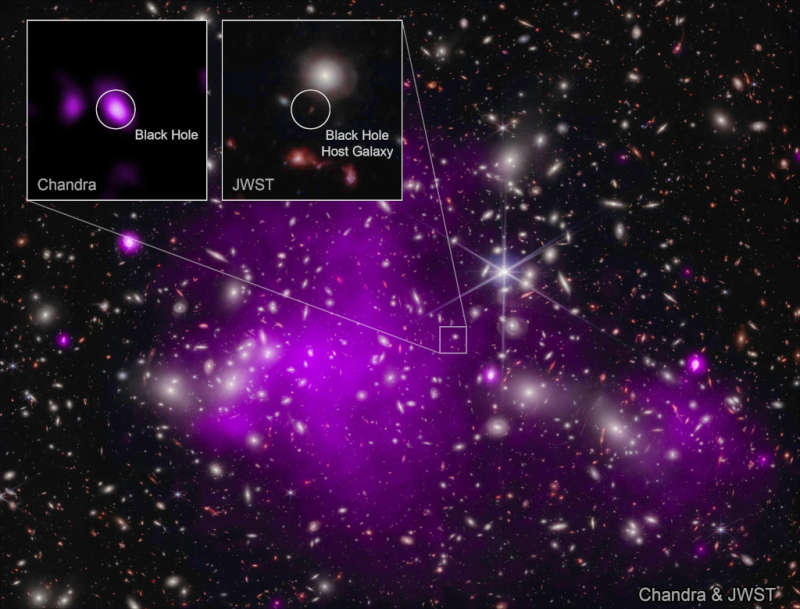Credit & Copyright: X-ray:
NASA/CXC/SAO/ckos Bogdcn;
Infrared:
NASA/ESA/CSA/STScI;
Image Processing: NASA/CXC/SAO/L. Frattare & K. Arcand
Explanation:
Dominated by dark matter,
massive cluster of galaxies Abell 2744 is known to some as
Pandora's
Cluster.
It lies 3.5 billion light-years away toward the constellation Sculptor.
Using the galaxy cluster's enormous mass as a gravitational lens
to warp spacetime and magnify even more distant objects
directly behind it, astronomers
have found a background galaxy, UHZ1, at a
remarkable
redshift of
Z=10.1.
That puts UHZ1 far beyond Abell 2744,
at a distance of 13.2 billion light-years, seen when
our universe was about 3 percent of its current age.
UHZ1 is identified in
the insets
of this composited image combining X-rays (purple hues) from the
spacebased Chandra X-ray Observatory and
infrared light from the James Webb Space Telescope.
The X-ray emission from UHZ1 detected in the Chandra data is
the telltale signature of a growing supermassive black hole
at the center of the ultra high redshift galaxy.
That makes UHZ1's growing black hole the most
distant black hole ever detected in X-rays,
a result that now hints at how and when the first supermassive
black holes in the universe formed.
Image Processing: NASA/CXC/SAO/L. Frattare & K. Arcand
1999 2000 2001 2002 2003 2004 2005 2006 2007 2008 2009 2010 2011 2012 2013 2014 2015 2016 2017 2018 2019 2020 2021 2022 2023 2024 2025 |
Yanvar' Fevral' Mart Aprel' Mai Iyun' Iyul' Avgust Sentyabr' Oktyabr' Noyabr' Dekabr' |
NASA Web Site Statements, Warnings, and Disclaimers
NASA Official: Jay Norris. Specific rights apply.
A service of: LHEA at NASA / GSFC
& Michigan Tech. U.
|
Publikacii s klyuchevymi slovami:
cluster of galaxies - black hole - Skoplenie galaktik - chernye dyry
Publikacii so slovami: cluster of galaxies - black hole - Skoplenie galaktik - chernye dyry | |
Sm. takzhe:
Vse publikacii na tu zhe temu >> | |
